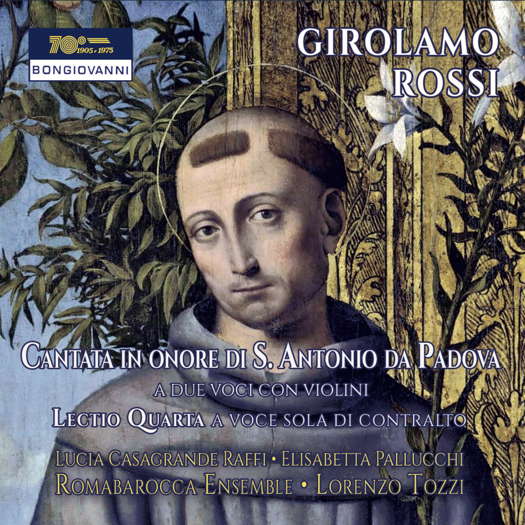- Antônio Carlos Gomes
- Gillian Wills
- Heinz Winbeck
- Music and Media Consulting
- Philip Lancaster
- Anthony Payne
- Thomas De Quincy
- Edward Nesbit: Drop down ye heavens

In Tune with the Changing Times
GIUSEPPE PENNISI discovers the eighteenth century Neapolitan composer Girolamo Rossi
'... an important discovery.'
In this magazine (and in its predecessor, Music & Vision), I have occasionally reported on live performances of the Romabarocca Ensemble. It is a small ensemble, led by director and harpsichordist Lorenzo Tozzi, who has had an important career at the prestigious Santa Cecilia Conservatory. He has now retired and devotes his life to music reviews for a major Roman daily and to the ensemble. Romabarocca has neither state nor regional support. It is fully self-financed, mostly by the musicians themselves. Their passion is to discover forgotten composers. Mr Tozzi spends a great deal of his time in musical libraries, dusting off ancient scores.
There are several composers called Rossi, a very frequent last name in Italy: Salomon Rossi (1570-1630) worked in Mantua with Monteverdi; Luigi Rossi (1598-1693) was well-known and appreciated in Southern Italy; harpsichord virtuoso Michelangelo Rossi (1600-1656) was quite successful in Genoa and Rome. Now, thanks to this CD, Girolamo Rossi - Naples, eighteenth century, the dates of birth and death are uncertain - becomes a star of the musical firmament in between the late Italian baroque period and the beginning of the classical period. This is thanks to this CD in which two compositions are juxtaposed: the Cantata in onore di Sant'Antonio di Padua for two voices and strings and Lectio Quarta for alto, psaltery and harpsichord. The former was originally performed in Naples in 1738 and the latter presumably in Rome or in Naples after 1760. The scores are about thirty years apart; yet, the listener senses that they belong almost to two different worlds. This indicates that Girolamo Rossi, albeit almost unknown until now, was very well in tune with the changing times during a complex and difficult century.
Bongiovanni published the CD in late June 2020. This is a musical publishing house in Bologna specializing in rare composers and in premiere recordings. The Cantata di Sant'Antonio di Padua was performed in concert form by Romabarocca in Padua a few months ago at the St Anthony Sanctuary for the Saint's anniversary, but then recorded in a studio for the CD. Lectio Quarta has been played and recorded in the studio just for the purpose of making this CD.
The Cantata includes a three part symphony, many short 'dry' recitatives, three recitatives with accompaniment and four arias equally distributed between the soprano (Lucia Casagrande Raffi) and the alto (Elisabetta Pallucchi). The Ensemble includes conductor Lorenzo Tozzi at the harpsichord, two violinists, Giuseppe Grieco and Roberto De Santis, and cellist Renato Criscuolo.
The Baroque flavour starts with the tripartite symphony - Allegro, Largo ed Amoroso and Balletto spiritoso.
Listen — Girolamo Rossi: Allegro (Cantata in onore di S Antonio da Padova)
(track 1, 0:00-0:45) © 2020 Bongiovanni :
It is very clear in the first soprano and alto arias.
Listen — Girolamo Rossi: Con echi festosi (Cantata in onore di S Antonio da Padova)
(track 5, 0:46-1:29) © 2020 Bongiovanni :
And it explodes in the duet.
Listen — Girolamo Rossi: d'ogni fedele il core (Cantata in onore di S Antonio da Padova)
(track 17, 2:47-3:43) © 2020 Bongiovanni :
This is Baroque, chiselled but not flowery, and thus very much in line with the style of the 'Roman School' that presumably had its followers also in Naples too, where most likely the Cantata had its debut. Interestingly, the Cantata was conceived to be very economical; yet, beginning with the symphony the three string instruments give the sense of being a much larger ensemble. In addition, the tone of the Cantata is not stately but nearly popular. Thus, this is a Baroque for church worship, not for princely palaces - another aspect of the rarity in this CD.
With its Latin text - St Augustine's commentary on Psalm 63, Lectio Quarta was most likely composed for a Good Friday celebration. Consequently, there is nothing popular either in the text or in the music. The use of the psaltery as the main instrument, with the harpsichord, suggests the 'high style' of the piece. The psaltery was quite common in ancient Medieval music but was rarely used during Baroque times; yet, it appeared again somewhat in the classical period in Europe and it was very popular (in various ways and variations) in Latin America (especially in Mexico) during the nineteenth century. On this CD, Heidelor Schauer (from the Salzburg Mozarteum) plays the psaltery in a masterly manner.
The score can be considered late Baroque but its style is close to the then starting classical music. One feels this from the introduction.
Listen — Girolamo Rossi: Introduzione (Lectio Quarta)
(track 18, 0:00-0:18) © 2020 Bongiovanni :
Multi martyres is engrossing.
Listen — Girolamo Rossi: Multi martyres (Lectio Quarta)
(track 21, 0:33-1:27) © 2020 Bongiovanni :
Parum ergo, the finale, is brilliant.
Listen — Girolamo Rossi: Parum ergo (Lectio Quarta)
(track 24, 3:05-3:49) © 2020 Bongiovanni :
In short, an important discovery.
Copyright © 10 September 2020
Giuseppe Pennisi,
Rome, Italy

CD INFO - GIROLAMO ROSSI: CANTATA IN ONORE DI S ANTONIO DE PADOVA
FURTHER INFORMATION: BONGIOVANNI RECORDS
FURTHER ARTICLES ABOUT EIGHTEENTH CENTURY MUSIC




